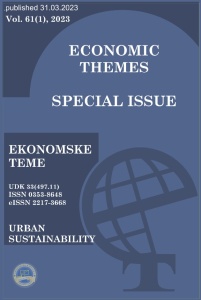Economic Themes (2023) 61 (1) 4, 63-84
Marina Toger, John Östh, Sabine Gebert Persson
Abstract: Using tracking technologies to measure revealed preferences can help detect locations with potential for further expansion or with risks of tourism overgrowth and consequential externalities. Understanding consumer behavior in spatio-temporal dimensions can reveal what contextual factors influence the consumption of a destination. This paper aims to contribute to knowledge on behavior-based segmentation by disaggregating spatial behavior of tourists in an intra-destination context. Behaviors were explored focusing on cruise tourists in Visby using GPS loggers and a gridded sighting experience dataset. To identify points of interest, tourists’ indicated their liking using GPS click-loggers. The results were compared to the spatial distribution of visible amenities and through a stepwise method, behavior-based segments grounded in movements and positive emotions were derived. The paper contributes to previous research on intra-destination tourist mobility by developing a method for identifying revealed behavior, and developing segments that can be used to match tourist interests to distribution of amenities. The method aims to provide stakeholders with tools that can facilitate their strategic management and marketing of a destination.
Keywords: tourism; behaviour-based segmentation; GPS; amenities
WHAT YOU SEE IS WHERE YOU GO: CRUISE TOURISTS’ SPATIAL CONSUMPTION OF DESTINATION AMENITIES
Marina Toger, John Östh, Sabine Gebert Persson
Abstract: Using tracking technologies to measure revealed preferences can help detect locations with potential for further expansion or with risks of tourism overgrowth and consequential externalities. Understanding consumer behavior in spatio-temporal dimensions can reveal what contextual factors influence the consumption of a destination. This paper aims to contribute to knowledge on behavior-based segmentation by disaggregating spatial behavior of tourists in an intra-destination context. Behaviors were explored focusing on cruise tourists in Visby using GPS loggers and a gridded sighting experience dataset. To identify points of interest, tourists’ indicated their liking using GPS click-loggers. The results were compared to the spatial distribution of visible amenities and through a stepwise method, behavior-based segments grounded in movements and positive emotions were derived. The paper contributes to previous research on intra-destination tourist mobility by developing a method for identifying revealed behavior, and developing segments that can be used to match tourist interests to distribution of amenities. The method aims to provide stakeholders with tools that can facilitate their strategic management and marketing of a destination.
Keywords: tourism; behaviour-based segmentation; GPS; amenities

